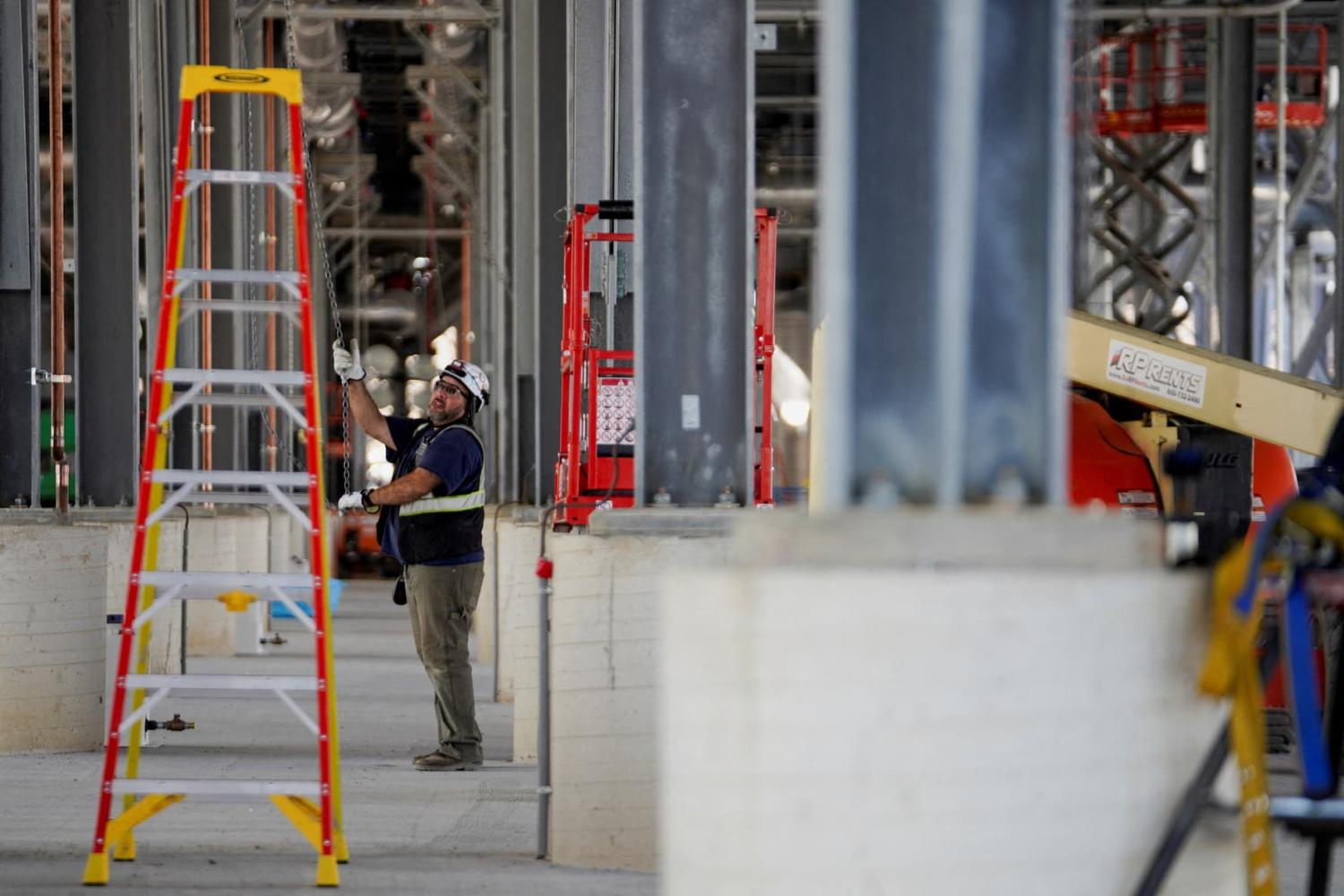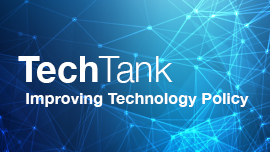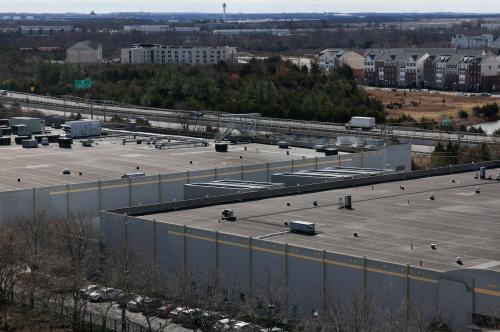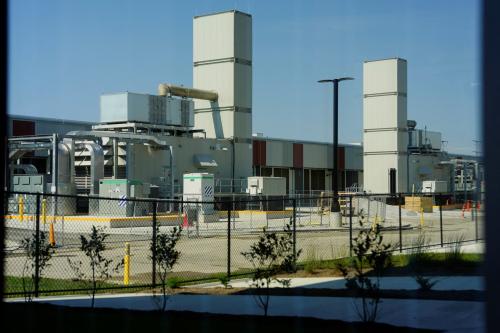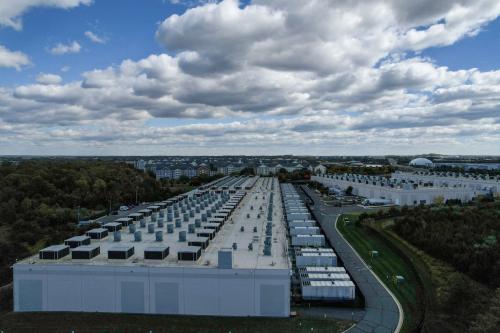Artificial intelligence is the transformative technology of our time. As argued in the Brookings Press book, “Turning Point: Policymaking in the Era of Artificial Intelligence,” it is powering applications in finance, health care, education, transportation, defense, and e-commerce, among other sectors. AI’s ability to process large amounts of information and act independently on that basis is altering communications, service delivery, financial transactions, administrative processing, and a host of other areas.
Undergirding this growing use of AI is the need for state-of-the-art data centers. This paper examines the future of these entities. It examines what they are, their numbers and distribution, the different types of centers, financial investments, barriers to development, workforce impacts, economic implications, and considerations for guiding their future growth. Briefly, we argue for a framework for data centers that addresses challenges such as access to critical minerals, workforce shortages, community benefits, permitting reforms, energy and water needs, electric grid investment, national security considerations, and geographical placement. Improvements in these areas will be crucial to ensuring a smooth transition to a digital economy.
Data centers host a large number of file servers and networking equipment that can store, process, and analyze text, images, code, and other information sources. Guided by large language models (LLMs) and machine learning, data centers can parse through these materials and act autonomously upon the derived insights. The applications that are hosted at these facilities can summarize text, edit photos or videos, examine data, code software, and perform many administrative and financial tasks in real time. These applications offer tremendous convenience, efficiency, and effectiveness to consumers, businesses, and governments.
“Hyperscale” data centers typically have more than 5,000 file servers within their facilities and can house equipment utilized by many different organizations. With the large-scale growth of generative AI, there is tremendous reliance on data centers that process information quickly and with low latency to enable the use of a wide range of AI services and agents. It is estimated that the generative AI market is accelerating around 40% a year and is projected to increase from $43.9 billion in 2023 to nearly $1 trillion in 2032. This high AI growth rate, generated by skyrocketing digital demand, makes it imperative to expand data centers.
There are different kinds of data centers. One type is data centers for generative AI, which are based on graphics processing units (GPUs) that can deal with vast amounts of information. These facilities process extraordinary amounts of data in text, numeric, or graphic forms and power LLMs and machine learning. They scour the internet, find logical patterns, summarize information, and act on these insights in real time. AI-directed data centers require high computing power and are energy-intensive. As interest in generative and agentic AI has skyrocketed and major tech companies roll out new AI products, there has been a substantial growth in these types of operations. Data center facilities can be enterprise systems operated on behalf of a specific organization or co-location centers that host the platforms of multiple organizations.
One of the most sensitive developments has been high-security centers for military and intelligence gathering. Governments have substantial security needs and require online platforms that house their most confidential secrets, including information on defense applications, battlefield logistics, foreign adversaries, or domestic terrorists, as well as proprietary systems provided by private firms. Processors need to be super-fast to analyze incoming material and super-secure from hackers, malcontents, and enemies. President Trump’s recently launched AI Action Plan directs the Department of Defense and the National Institute of Standards and Technology (NIST) to develop new technical standards for government entities.
“Edge centers” are situated close to particular activities they support, in order to reduce the latency of computation and networking. Applications such as autonomous vehicles, stock trading, or manufacturing facilities with widespread use of robots need fast communications. These systems don’t want too much of a lag between a query and its implementation. Human lives may also depend on speed in analyzing certain risks, so these kinds of centers need to be very close to where people are utilizing their services.
Data centers supporting AI applications require a considerable amount of electrical power and water for their computer storage and processing. In particular, LLMs and other forms of generative AI need a tremendous amount of power. In 2023, data centers consumed around 4.4% of America’s electrical power, and that percentage is expected to rise substantially in the next years. According to the Lawrence Berkeley National Laboratory, energy growth is likely to increase between 6.7-12% by 2028. Around the world, it is projected that AI’s energy needs could account for as much as 21% of all electricity usage by 2030. According to McKinsey, American data centers will utilize 35 gigawatts of electricity by the end of this decade.
Water is a problem as well. Some data centers consume as much as 500,000 gallons per day, making them a substantial draw on what is a limited resource in many communities. Data centers require a lot of water to cool the buildings and the computers inside. Electronic devices heat up during processing, and when thousands of file servers are grouped in a small area, the cooling needs increase dramatically.
Clean water is in short supply in a number of places. This is especially a challenge in the Rocky Mountain states and on the West Coast. In numerous cities and communities, water rates are rising substantially to deal with short supply and increasing demand. One county in Georgia is raising its rates by 33%, far higher than the usual low single-digit increase, which critics attribute to data center needs. New advances in microfluidics, where coolants are applied directly to chips, may improve our ability to cool semiconductors and make data centers more sustainable and less energy-reliant, but much is still unknown about the efficiency of such advances.
As data centers expand, the question is how to generate the energy and water they need. The bulk of American electricity currently comes from fossil fuels such as natural gas (43%) and coal (16%), followed by wind, solar, and thermal (21% together), and nuclear energy (18%). Diversifying energy sources will be essential to meeting the growing demands of data centers, which cannot operate reliably without significant improvements in U.S. energy production.
Nuclear power appears to be rising as a possible energy source, with AI companies planning to open or reopen new plants in the United States. It offers the advantage of not generating the byproducts of fossil fuel consumption while being available all the time once facilities go online. The Three Mile Island plant suffered a partial meltdown in 1979, but it is planned to reopen in 2028 to power Microsoft’s data centers, provide 3,400 jobs, and generate billions in new tax revenue.
This increase in energy needs is occurring against the backdrop of rollbacks on clean energy sources. One organization estimates there will be 344 gigawatts of lost generating power over the next decade linked to the 2025 federal budget bill. Provisions in the bill, particularly changes to tax credits, undermine the financial viability of solar and wind generators and make it harder for consumers to afford the electricity they generate. At a time of dramatically rising energy needs, it is short-sighted for the Trump administration to cut back on renewable energy sources, especially those that will be needed to operate data centers.
Overall, it is clear that the United States will need a substantial boost to electrical production to meet the increased demand of AI and data centers. Companies may mitigate these needs by developing more efficient cooling, lighting, and semiconductor processors. Greater transparency about their energy and water use would also enable policymakers and researchers to better understand the scope of the challenge and plan for sustainable growth.
It is hard to get complete information on the number of data centers because of the ambiguities in how they are both defined and perceived by the market. Since there is no central clearing house regarding the numbers in operation, under construction, or in the planning stage, it is imperative that some type of future dashboard be developed. But according to the available data shown below, there are now an estimated 11,800 data centers around the world, powering AI and the digital economy. The United States leads the world in the number of centers as of June 2025, followed by Germany, the United Kingdom, China, and France. Around two-thirds of existing data centers are located in the United States, China, or Europe, and only a small number are found in Africa, Latin America, India, or other regions in the Global South. As is outlined later in the paper, geographic inequities will be crucial in assessing the global impact of data centers.
Table 2 breaks down data center numbers by U.S. state, based on two different sources: DataCenterMap.com and Aterio. As with the global estimates, the overall numbers vary considerably depending on how data centers are defined, the stage of construction and operations, and the time period being covered. Some inventories appear to include small-scale centers, while others stick to larger facilities.
The state of Virginia has the largest number of data centers, followed by Texas and California. Northern Virginia has emerged as the “Silicon Valley” of data centers because of its proximity to federal government agencies, which make extensive use of data storage and processing, in addition to the availability of land, energy, and water sources that support data center operations.
Table 2 also makes clear that the number of newly announced data centers continues to grow. States and localities are actively competing to attract these facilities in pursuit of economic growth. Several states view data centers as essential to establishing themselves as digital hubs for AI and other emerging technologies.
Some of the most important barriers to data center expansion involve the critical components used for their construction and deployment. These facilities need a considerable amount of copper, steel, and aluminum for the building and equipment, as well as semiconductors, electronics, fiberoptics, and wiring for file servers, storage devices, and networking equipment.
President Trump’s decision to impose tariffs on many commodities has dramatically raised the price tag of data centers. This year, the administration imposed tariffs of 50% on copper and raised rates from 25 to 50% on steel and aluminum. These measures dramatically increase the construction and operating costs for data centers.
The costs of semiconductors and electronic equipment imported into the U.S. have also increased by 25%. These increases are meant to boost domestic production and reduce trade deficits with major trading partners. This could eventually happen, but it is hard to construct new facilities and redirect supply chains in a short period of time, especially simultaneously with the expansion of data centers. While tariff negotiations with individual countries continue, the uncertainties associated with this policy remain a drag on data center construction in the United States.
One worrisome policy concern is that while President Trump’s AI Action Plan prioritizes data center construction, his approach to tariffs makes this effort far more expensive. Alternative U.S. suppliers that could reduce costs are also limited, highlighting the inconsistencies between AI national goals and policy implementation. If the United States is to sustain its global leadership in AI, any barriers to data center development (whether stemming from trade policy or supply chain) will impact the timing and sustainability of construction. Despite billions in investments, logistical and permitting obstacles continue to delay data center buildout and operations, as discussed later in this paper.
A major limiting factor in semiconductor manufacturing is China’s control over critical minerals needed for their production. Materials such as gallium, germanium, antimony, tungsten, tellurium, bismuth, indium, and molybdenum are vital for many products and are not readily available from domestic sources.
Furthering the problem is that getting mining permits in the U.S. and Europe can take many years, while countries such as Canada, Australia, and China have far shorter timelines. The length of time required for U.S. and European mining permits limits domestic production of semiconductors and electronics and harms the ability to expand data centers. In the U.S., there is a growing urgency to expedite mining permits and justify the domestic expansion and construction of data centers. Without reliable access to prime materials, overbuilding is a possibility, and in the absence of long-term commitments from AI companies, vast amounts of land could become “data center deserts” if cheaper alternatives emerge elsewhere.
Data centers will spur labor demand, particularly in construction and engineering, where there might be a groundswell in job opportunities and subcontracts. However, the current workforce simply does not have the necessary supply of technical workers. The Trump administration’s current immigration and deportation policies compound this workforce problem, especially when it comes to the software engineers needed to power data centers. While the lack of homegrown talent could be resolved with workers from other countries, the current administration has moved in the opposite direction, deporting workers and slowing the supply of foreigners coming into the U.S.
There aren’t enough electricians in the U.S. to meet the demand for laying wires and construction workers to build data centers. There are also shortages of construction workers, which typically include a large number of immigrant workers. It has been estimated that roughly 30% of construction workers in the U.S. are immigrants, including some who are undocumented. However, mass deportations limit the growth of data centers by draining the supply of individuals needed to build and wire such facilities. In every sector involved in data center development, from tech to blue-collar and trade, the Trump administration’s immigration crackdown works against its stated goals of furthering American leadership in AI and expediting the construction of the data centers supporting it. This approach contradicts an early commitment made to the major AI companies, which expect reciprocity for their support of the broader Trump agenda.
To redress the labor shortages threatening data center expansion, the U.S. should expand its job training and vocational education programs. More flexible licensing of workers in the trades should be encouraged across states; for example, electrician certifications could be made easily transferable, allowing for more geographic mobility of workers with the necessary skills. The U.S. Department of Labor, in coordination with state workforce agencies, could support a temporary or flexible labor initiative tailored to large-scale data center construction. A stronger national commitment to the skilled trades overall would go far toward closing existing workforce gaps.
When workers can be found, housing problems are an additional concern. Housing costs have skyrocketed in many places, and trade workers will need affordable and reasonable accommodations, especially in expensive areas where data centers are concentrated, like Northern Virginia. Some firms already provide mobile homes as temporary housing for these individuals; based on the expeditious and lofty agenda to build data centers, this could be a viable option.
Finally, most states require inspectors in construction with the duty to keep workers safe. Many places don’t have enough inspectors, slowing down facility development. Even if completed, projects will be stalled until inspectors certify each facility. This is yet another sign that greater coordination between state and local agencies to address these worker shortages is necessary.
Obtaining state and local permitting for data centers can take a long time. There are mandated checks for the environment, worker safety, and community well-being. Companies need to get easements and right-of-way privileges to move forward. Some community groups have organized to stop construction. In Northern Virginia, for example, which is home to a sizeable percentage of the world’s data centers, neighbors of adjoining properties have complained in recent years about water shortages, light pollution, and air conditioning noise. Companies need to make sure their sites are safe and clean, and do not endanger community residents.
In its AI Action Plan, the Trump administration is pushing for expedited permitting. Republican lawmakers have repeatedly voiced that current processes are unnecessarily slow and more needs to be done to help companies that want to build technology facilities. The administration is likely to authorize building sites on federal lands under a fast-track system designed to reduce approval times, freeing up unused terrain for large-scale data centers and helping companies move more quickly from permitting to construction.
Another proposal is to exempt data center projects from certain review requirements dictated by the National Environmental Policy Act, the Clean Water Act, and the Clean Air Act. Another is to have national permits for data centers as opposed to locally required ones. While these measures might expedite construction, communities may still oppose the projects, especially if residents are not involved from the beginning.
Among the most critical infrastructure priorities are modernizing transmission lines and ensuring that the electric grid can operate at the required scale, stability, and reliability. With the dramatic increase in electricity needed for data centers, upgrades to the grid will be necessary. It can sometimes take up to 10 years to build the transmission lines that move electricity from region to region. Such transmitters rely upon steel and aluminum, but researchers say materials such as carbon fiber would be lighter and could move larger amounts of electricity. The U.S. Department of Energy intends to upgrade 100,000 miles of new transmission lines this decade, though AI companies are seeking to build many of these data centers on a much shorter timeframe.
With the growth of AI and the design of new materials, there are new tools that will make transmission lines operate more efficiently. AI can improve operations and facilitate a more efficient and sustainable electrical system, preventing loss of power as electricity is moved geographically. In addition, data centers can use “closed cooling systems” that require less water and keep file servers at the temperatures needed for effective operation. These measures will reduce energy costs and keep water and energy demands down.
It is also possible that there will be improved efficiencies in other areas. The Chinese firm DeepSeek, for example, claims it can process tremendous amounts of information with reduced processing power, lower costs, and fewer electrical requirements. A recent peer-reviewed Nature article co-authored by a company leader said DeepSeek’s “reasoning-focused R1 model cost $294,000 to train and used 512 Nvidia H800 chips,” which is a fraction of what most Western models require to operate. While it is not clear how seriously to take such claims, digital technologies have a tradition of becoming more efficient over time; it is possible that design and processing improvements will increase financial and energy sustainability, thereby easing the current pressures facing data centers. AI companies will face many of the same regulatory and state-level hurdles that energy companies do, as was the case in the expansion of 5G technology, when colocation of radios and power generators became a concern. Securing access to modern and resilient power systems may prove one of the stickier points for AI companies.
Many factors go into the costs of data centers, including acquiring land, construction, equipment, labor, heating and cooling, security, power consumption, permitting, operations, and more. Jeff Howell of Encor Advisors has examined this issue in-depth and found that “construction costs for data centers are estimated to average at approximately $9.5 million per megawatt” in the U.S., and once facilities are built, annual operating expenses can range from $50,000 to $100,000 for a small center to $10 to $25 million for a larger facility.
Recent hyperscale data centers that feature thousands of servers were found to cost $1 billion or more to build. They can cover more than a million square feet of land and feature sophisticated computer processing power. In addition to being very expensive, such facilities have huge upfront costs. Many of these expenditures, such as land and construction labor, vary tremendously within the United States, and the same is true for different places around the world. How close installations are to supply chains affects overall costs, as do transportation, logistics, energy, and taxes.
Billions of dollars are currently being invested in AI, cloud computing, and the data centers that power digital applications. Money is flowing from the top tech firms, investment funds, sovereign wealth funds from other countries, financial institutions, industry partnerships, and more. As of 2024, the financial investment required for data centers reached hundreds of billions of dollars, and that number is expected to increase into the trillions by 2030.
Barring major advances in efficiency, the big question is who pays for the increased data center capacity. Right now, ratepayers shoulder some of these costs. Consumer bills have risen in a number of places, fostering resentment about the additional expenses. David Klaus and Mark MacCarthy have argued that since the major technology companies are building data centers and will benefit from their services, they should shoulder more of the costs. They note that the top AI firms have a market value “seven times that of the entire S&P 500 Utility Sector” and therefore have the financial means to pay for the increased electrical power. As an illustration of how this could work, the Public Utilities Commission of Ohio has proposed that firms operating data centers larger than 1 gigawatt should pay 85% of their electricity costs, up from the current 60%. This change would shift a greater share of financing to technology firms with the capacity to absorb it.
To guard against the consumer backlash over rising electrical bills, several companies are using bonds to finance their long-term investments. Meta, for example, has floated $26 billion in bonds to pay for its new data centers. That allows the company to gain access to capital upfront, with expected revenue gains from AI applications paying for the bonds overtime. That model puts the payment onus more on companies but also assumes the cash flow from new AI revenue will be sufficient to cover bond repayments. If AI accelerates as currently are projected, that should be a relatively safe bet.
Because of the high investment costs, many of the current hyperscale data centers are set up by the large technology firms themselves. According to the scholars at Vanderbilt University, platforms such as Amazon Web Services, Microsoft Azure, and Google Cloud Platform own around two-thirds of the cloud computing market, which serves as the digital infrastructure for the data center sector. Data centers rely upon cloud storage and processing facilities to power AI and other emerging applications, making it essentialy to ensure these markets function efficiently and effectively.
Consumers, businesses, and government actors will likely benefit if the development of large-scale data centers spurs advancements in AI applications, machine learning, data analytics, and robotics, which in turn could lead to more efficient manufacturing, autonomous transportation systems, the development of new drugs, personalized learning, and much more. There will be faster broadband for ordinary consumers and greater processing power for businesses, governments, and health and educational institutions, especially if the assets of telecommunications companies are effectively leveraged.
Our goal should be to extend the benefits of the digital revolution to everyone, allowing people to share in technological innovation without facing exclusion or harm.
This is where the question of community benefits for residents living near data centers must be made clearer. For example, can local electrical grids be upgraded as part of the broader infrastructure improvements needed to power these facilities? Could irrigation systems be modernized in areas slated for data center construction? Who decides what community investments are made, and how are tech companies and the government working to support local education and workforce development so that residents can access new trade and professional opportunities?
As more data centers are built, multiple stakeholders, spanning AI companies to civil society organizations, should consider the risks of accelerated growth. There should be community surveys to understand people’s concerns and ways for public utility commissions to gather feedback from affected neighbors and incorporate that information into their rate decisions. In other words, communities should not view these buildings as isolated entities, but rather as valued assets that bridge local dynamics with global concerns, as well as an opportunity for local development.
One area of community benefit that might be less promising is job creation. Even in large-scale centers, construction jobs often total around 1,500 skilled trade workers and 100 operational jobs. Since centers largely consist of file servers and networking equipment, it does not take a lot of employees to staff them. Hyperscale data centers may comprise a million square feet of space and cost a billion dollars to build, but they are not likely to create a large number of jobs outside of construction, which is why other community benefits may be more salient for regions expanding their data center footprint.
Natural disasters are major threats to data centers. The prevalence of U.S. data centers in places such as Texas, California, and Virginia makes them susceptible to hurricanes in the Southeast, floods in Texas and Virginia, and earthquakes along the West Coast.
As climate change fuels more destructive floods and storms, companies must carefully select the construction sites of new data centers. In disaster-prone areas, it is also crucial to build in data and operational redundancy in case particular centers go down due to weather problems.
Increasingly complicated geopolitical dynamics are affecting data centers. Shifting alliances and the polarization of global relations alter the United States’ risk profile. Competition with China has intensified, and so have concerns about national defense, cybersecurity, and international competitiveness. Decisions about where to build data centers carry national security implications, raising questions about the nature of a host nation’s relationship with the United States and its level of democratic governance. Careful deliberation about these subjects is necessary, as the implications on intelligence gathering and defense are significant.
On the hardware side, the Biden administration dealt with some possible security threats by limiting chip exports to adversarial countries. It imposed controls on the kind and sophistication of semiconductors that American firms could sell to Chinese entities, for example. It invested in domestic manufacturing capabilities through the CHIPS and Science Act, in order to boost American capabilities and make sure U.S. companies had access to chips in case of any disruptions in production in Taiwan and South Korea, where the most advanced chips are made.
Trump has altered that strategy in two ways. He has weakened support for CHIPS Act funding and loosened restrictions on chip sales to China. The administration’s argument is that it is better to have foreign competitors reliant on American products than for them to develop their own domestic capabilities. The belief is that these actions will protect American security, while still maintaining export markets to China and elsewhere.
It is important for organizations to avoid data center “lock-in” and have the means to move their information and models from platform to platform. While this was a problem in the early days of some social media sites, companies can now export their data and switch to another platform if they choose.
There should be a similar mechanism for convenient data migration so that individuals and organizations are not locked into individual sites with limited migration options. Both the General Data Protection Regulation (GDPR) of the European Union and the California Consumer Privacy Act (CCPA) give people control over their own data and mandate the data portability rights of any individual or organization. This requirement should be extended throughout the U.S. to give people more choices and greater control over their personal information and applications. In the future, more interoperability could be built into data centers to ensure more seamless data coordination.
Europe faces some distinctive challenges in building out data centers, owing to the inadequacy of its current power grid, permitting obstacles, and poor access to capital in order to scale its businesses.
It is expensive to build data centers in many European nations. There are high land costs, cumbersome permitting procedures, high labor and tax costs, and infrastructure development barriers. Similar to the U.S., the members of the European Union must address these obstacles and ensure their businesses have access to the data centers that will power the AI economy.
In general, the European Union has been slow to overcome barriers to data center development and is building these facilities at a far slower rate than the United States. A similar challenge could emerge domestically if U.S. states diverge in how they support data center construction. However, as Table 2 indicates, state-level approaches in the United States have so far remained consistent, enabling effective coordination with federal initiatives to advance these projects.
Most data centers now reside in American states on the East or West coasts or in developed countries that already have ample financial resources. There is a real risk that the U.S. hinterland will be left behind, as well as the Global South, including substantial parts of Africa, Latin America, and Asia. Table 1, for example, shows that there are no African countries with a substantial number of data centers, and the only Global South nations among the top 16 places were Brazil and Mexico.
The problem with the narrow geographic scope of data center locations is that it reinforces existing inequities and accelerates the gap between digital “haves” and “have-nots.” Data centers are crucial for future economic development. It will be hard for nations to be competitive if they do not have their own data centers or if their AI applications lag due to insufficient infrastructure. We need a geographical distribution of data centers that promotes economic growth in the Global South and enables AI for the public good around the world.
To deal with equity issues, Daniel Goetzel of Harvard University has discussed “AI economic zones” as ways to diversify the geography of AI and data centers. The idea is that cities could establish areas similar to urban economic zones where public and private investment could facilitate technology developments and make it easier for those without much access to capital to develop their ideas. Similar approaches may work globally through the World Bank or other international development agencies.
In summary, several obstacles and barriers must be addressed to enable data centers—and, by extension, AI applications—to reach their full potential and support economic flourishing. Challenges involving critical minerals components, workforce shortages, permitting reforms, energy and water needs, electric grid investment, national security, and geographical distribution are all critically important. Improvements in all these areas will be crucial to the international competitiveness and economic prosperity of the United States. This paper is part of a broader research effort to monitor these and other emerging areas and track community benefits and risks, while measuring progress toward national and international goals.
-
Acknowledgements and disclosures
Amazon, Google, Meta, and Microsoft are general, unrestricted donors to the Brookings Institution. The findings, interpretations, and conclusions posted in this piece are solely those of the authors and are not influenced by any donation.
The Brookings Institution is committed to quality, independence, and impact.
We are supported by a diverse array of funders. In line with our values and policies, each Brookings publication represents the sole views of its author(s).


